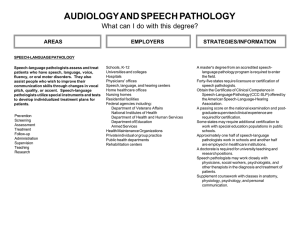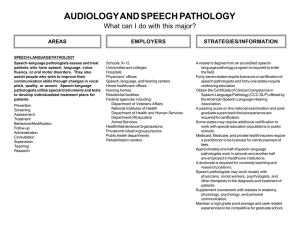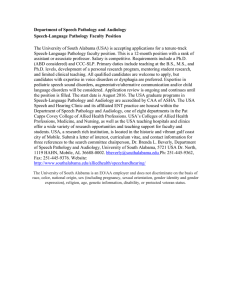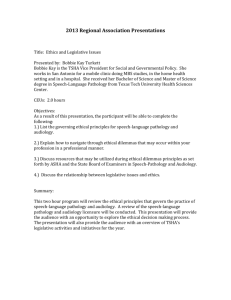Communication Disorders Study Guide: Definitions & Requirements
advertisement
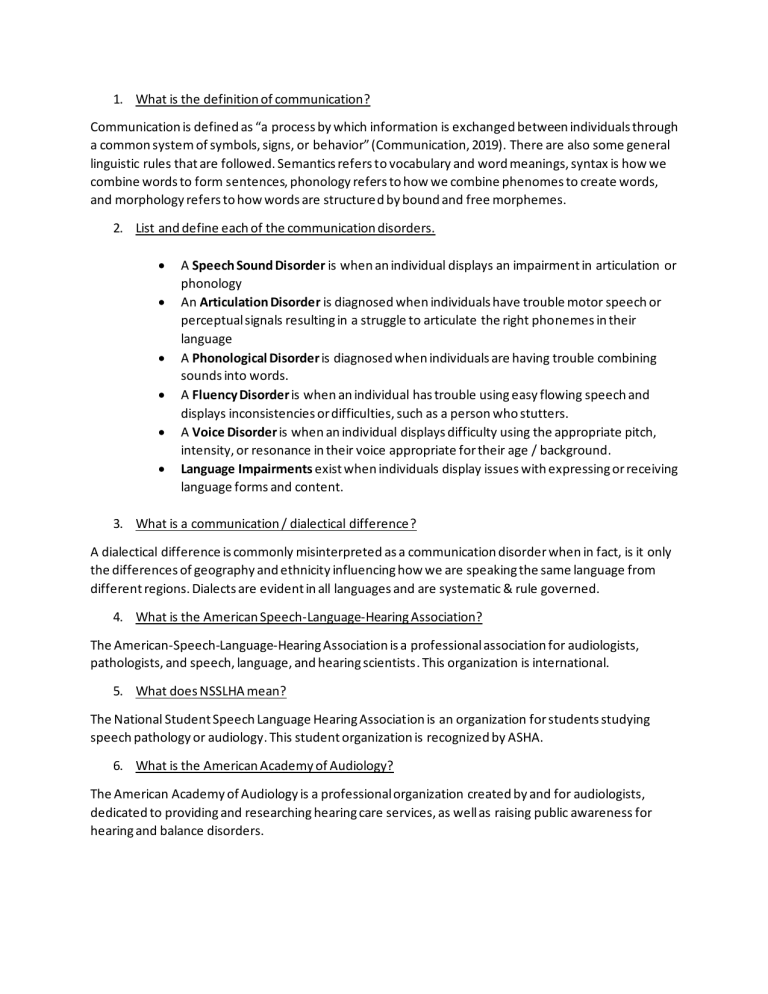
1. What is the definition of communication? Communication is defined as “a process by which information is exchanged between individuals through a common system of symbols, signs, or behavior” (Communication, 2019). There are also some general linguistic rules that are followed. Semantics refers to vocabulary and word meanings, syntax is how we combine words to form sentences, phonology refers to how we combine phenomes to create words, and morphology refers to how words are structured by bound and free morphemes. 2. List and define each of the communication disorders. • • • • • • A Speech Sound Disorder is when an individual displays an impairment in articulation or phonology An Articulation Disorder is diagnosed when individuals have trouble motor speech or perceptual signals resulting in a struggle to articulate the right phonemes in their language A Phonological Disorder is diagnosed when individuals are having trouble combining sounds into words. A Fluency Disorder is when an individual has trouble using easy flowing speech and displays inconsistencies or difficulties, such as a person who stutters. A Voice Disorder is when an individual displays difficulty using the appropriate pitch, intensity, or resonance in their voice appropriate for their age / background. Language Impairments exist when individuals display issues with expressing or receiving language forms and content. 3. What is a communication / dialectical difference? A dialectical difference is commonly misinterpreted as a communication disorder when in fact, is it only the differences of geography and ethnicity influencing how we are speaking the same language from different regions. Dialects are evident in all languages and are systematic & rule governed. 4. What is the American Speech-Language-Hearing Association? The American-Speech-Language-Hearing Association is a professional association for audiologists, pathologists, and speech, language, and hearing scientists. This organization is international. 5. What does NSSLHA mean? The National Student Speech Language Hearing Association is an organization for students studying speech pathology or audiology. This student organization is recognized by ASHA. 6. What is the American Academy of Audiology? The American Academy of Audiology is a professional organization created by and for audiologists, dedicated to providing and researching hearing care services, as well as raising public awareness for hearing and balance disorders. 7. Define speech-language pathology. Speech-language pathology is the treatment and study of speech, language, social communication, cognitive-communication, and swallowing adults in children and adults. 8. Define audiology. Audiology is a branch of science that studies hearing, balance, and related disorders. Audiologists prevent damage related hearing, as well as general hearing loss. 9. What are the academic requirements for CSD graduate students? Students who decide they want to complete the undergraduate degree program will then be ready to apply for the graduate program in Audiology. Students pursuing degrees in other fields will be required to complete a set of pre-requisite courses in CSD. A GPA of 3.00 or higher is required, graduate record examination scores, an essay or biosketch, and letters of recommendation are all requirements. 10. What are the academic requirements for Au.D graduate students? The entry level degree to practice as an audiologist is the clinical doctorate. This requires a completed undergraduate degree or a completed set of pre-requisite courses. A bachelor’s degree with a cumulative GPA of 3.00 or higher is required on all courses taken to be eligible for this program. A broad general education is expected to serve as a general background prior to their study. 11. What are the clinical requirements for CSD graduate students? A student must obtain a minimum of 400 clocked hours of supervised clinical experience in the practice of speech-language pathology. Twenty-five of those 400 hours must be spent in guided clinical observation while the rest must be spent in direct client / patient contact. A clinical fellowship year is also required, full-time or part-time. A PRAXIS exam is another requirement, as well as applying for a certificate of clinical competence from ASHA after completion. 12. What are the clinical requirements for AuD. graduate students? Students must complete 1,820 hours of supervised clinical practicum by certified audiologists holding the CCC in audiology. 13. Who accredits graduate programs? The CAA offers accreditation programs for eligible clinical doctoral programs in audiology and master’s programs in speech-language pathology. This prepares students for entry into the profession. All clinical work is going to be supervised by certified speech-language pathologists. 14. What is the Certificate of Clinical Competence in audiology and speech-language pathology? The certificate of clinical competence is the only universally recognized credential for the profession. It is granted by the American Speech-Language-Hearing Association. 15. What are the employment rates for SLP’s and audiologists? According to the Bureau of Labor Statistics (2019a), employment rates for SLP’s are expected to increase by 18% at a much faster rate than other occupations. Audiologists employment rates are expected to increase by 21% during the same time period. 16. What types of employment settings are available for both audiologists and SLP’s? Employment settings for these professions include but are not limited to educational facilities, health care facilities, and administrative roles within any of the work settings.
